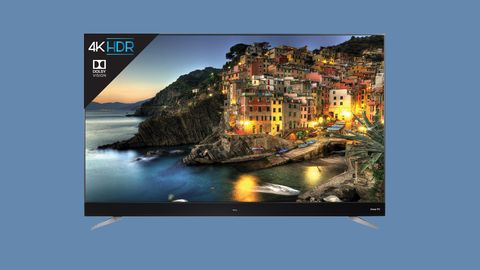TechRadar Verdict
TCL’s 2017 C-Series of TVs are simply gorgeous. They’re well-designed and, when fed 4K/HDR content, really shine. Unfortunately, however, problems with HD/SDR playback and lackluster audio performance make them less appealing than the company’s exceptional P-Series, but they’re worth considering all-the-same.
Pros
- +
Strong 4K/HDR performance
- +
HDR10 and Dolby Vision
- +
Roku TV built-in
Cons
- -
Issues with glare
- -
Upscaling isn’t world-class
- -
Soundbar doesn’t justify the cost
Why you can trust TechRadar
You have to love how simple TCL has made its line-up this year - there are just four series: the D-Series, S-Series, the P-Series and the C-Series.
The D-Series is for the value customers - the folks who are combing the newspaper ads on Black Friday looking for the cheapest screens. The P-Series, adversely, is all about performance. The TCL P607 was one of our favorite screens of 2017 for that reason. The S-Series is sort of the in-between. It has some neat features, but it’s still super affordable.
So what’s the deal with TCL’s C-Series? The ‘C’ stands for contemporary design. The very obvious implication here is that it’s a TV that looks nice - and it does - but more than that the contemporary design is true to its name, offering both an attached sound system hidden behind a mesh grille and a bevy of ports that can connect up to 4 HDMI sources.
If all that isn’t contemporary enough for you, it comes with Dolby Vision and Roku TV built-in, two modern TV technologies that help the C-Series compete with screens that cost twice as much.
This technology, alongside the exceptionally sleek design, make the C-Series a TV worthy of an audition in your home theater. That said, there are just a few problems with it that you should know about before going all-in on this screen.
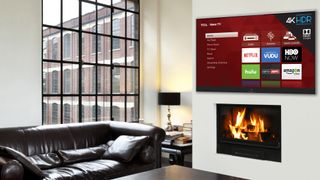
Design
One area that you won’t find an issue is the overall trim of the TV - it’s slim, sleek and looks great sitting on a home entertainment center.
The TV comes in three versions: a 55-inch and 65-inch version, plus a newly announced 75-inch model. The model we’ve chosen for review is the manageable - and decently affordable - 55C807, which comes in at $649.
The distinguishing factors for the C-Series is the super trim bezel, attached soundbar and microphone-equipped remote that allows you to use voice search on Roku TV. (If you can live without that last feature, consider picking up the slightly cheaper C803.) The additional audio piece provides a substantial boost to the TV’s sound, but it also makes the TV a bit chunky around the sides and not something you’d have hanging on your wall.
Spin the TV all the way around to the back and you’ll find plenty of ports: three HDMI 2.0 ports with HDCP 2.2, one HDMI 2.0 port with ARC, one USB port plus AV In, 3.5mm out, Digital Optical Audio and an Ethernet port. It’s about the best you’re going to do without hooking a screen up to a multi-channel receiver.
To prop the TV up, the C-Series comes with a set of two metallic legs that slide into the chassis with relative ease. The whole setup process takes less than five minutes, with the hardest part being registering the TV with Roku. (That’s not hard either, especially if you already you’ve owned a Roku player at some point in your life.)
The one key problem with the design isn’t something TCL included, but rather something that didn’t make its way to the screen: an anti-reflective coating. Without it, glare becomes a serious issue for the screen - especially if you place the screen in a living room near a window. Unfortunately, that means if you can’t create a completely dark environment for your screen, keep in mind that you’ll probably encounter some form of glare during day-time use.
Design TL;DR: The trim of the TV is exceptionally sleek and ultra-minimal. It packs plenty of ports, an attached soundbar and a microphone-equipped remote if you opt for the higher-end C807 model.
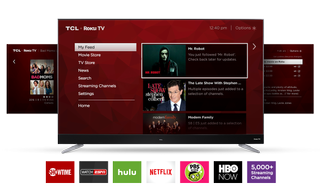
Smart TV (Roku TV)
Arguably the best decision TCL has made in years is backing Roku TV - probably the most robust, egalitarian and stable TV operating system on the planet.
If you’re not acquainted with the platform, picture an operating system that’s dead-simple to use, offers nearly every streaming service and rarely, if ever, crashes. It’s more or less the gold standard in operating systems.
To that end, navigating around the block-heavy interface is simple, with easy access to every app in the home screen. Can’t find what you’re looking for? Searching is just a voice command away while using the advanced microphone equipped remote on the C807.
The TV also comes equipped with 802.11ac Wi-Fi, which for those of us who have our TV too far away from our router, is a god-send.
New for platform in 2017 is the ability to label inputs (labeling one input as Xbox or DVD Player instead of Input 1, etc…), some additional smartphone features and, for the first time, Dolby Vision support.
Dolby Vision allows you to get the absolute most from the TV in terms of performance and - while tracking down Dolby Vision content is still a bit of a hassle at the moment - Roku does a good job highlighting all the available content in a new row in the 4K UHD Spotlight app.
On top of everything else, there’s also the Roku Channel which provides free content (with ads in between, of course) from the moment you turn the TV on. You usually won’t find an up-to-the-minute catalog of movie releases, but every once in awhile you’ll find a gem or two.
Smart TV TL;DR: Roku TV continues to be the gold standard for TV-based operating systems. It might not be the flashiest OS, but it’s simple, clean and open to everyone.
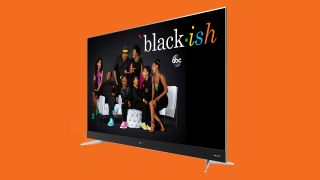
HD/SDR Performance
Although 4K/HDR beckons us with its alluring extended color gamut and copious pixel count, we are still bound, for now, to consume most content in HD/SDR.
But, thankfully, the good news here is that, despite not looking anywhere close to as good as the 4K/HDR content looks, HD/SDR content is palatable here ... even if you’ll notice a few major issues here and there with oversaturation and poor upscaling.
You’ll notice these failings the most when watching live-action content (among other things, we watched Indiana Jones and the Last Crusade and the Olympic Games in HD/SDR) and less when watching anything animated. Animation, by its very nature, plays nicely with the C-Series vibrant color palette while real human skin tone tends to skew off-kilter.
It’s also easy to easier to notice the lackluster black levels when you’re watching HD/SDR content. Any scene that tries to portray true darkness comes out an inky grey - which is partly a limitation of the panel technology, especially when stacked against OLED or the future-facing MicroLED technology.
Most of these problems come down to the panel technology TCL has chosen to go with on the C-Series. Edge-lit LED panels are cost-effective, sure, but they often give rise to uniformity issues that plague the screen. (See: oversaturation.)
These issues detract from the TV viewing experience and without a better upscaling engine on-board HD/SDR content generally looks like … well, HD/SDR content.
HD/SDR TL;DR: This is an area where TCL’s C-Series could use some real improvements in the future. Upscaling, oversaturation and black levels are all relatively large issues, and while the resulting images are passable, they’re far from class-leading.

4K/HDR Performance
Of course, a 4K HDR TV really shines when it has 4K HDR content. To that end, we’re thankful that Altered Carbon - the new Sci-Fi series on Netflix based on the book of the same name - was recently released and available to watch in Dolby Vision.
The show is the idyllic test subject. One moment you’re staring at a bleak cityscape that would make the cinematographer for Blade Runner green with envy, and the next you’re bathed in bright neon or even brighter blues of the sky that surround the Bancroft Mansion.
In 4K Dolby Vision, colors looked downright vivid with exceptional contrast and very good clarity. Sure, there were still issues with uniformity and oversaturation (again, a problem that is attributed to the panel technology itself) but they were at a more tolerable level here.
Putting aside the great-looking Dolby Vision spec for a second, TCL has done well to bring some of its own intelligent, proprietary display technology to the TV, our favorite of which is NBP Photon. This technology is what brings Wide Color Gamut (WCG) to the C-Series, and in practice, the results are extraordinary - blues are bluer, greens are greener and so on. (We have our suspicions that this is what causes oversaturation with HD/SDR content - but, when it comes to 4K/HDR, colors look vivid and bright, but still believable.)
In sum total, the C-Series does far better with 4K/HDR content than it does with HD/SDR. Dolby Vision and NBP Photon can really show off the TV’s stronger suits, and while they don’t erase the issues mentioned above, they do a fantastic job lessening their impact.
4K/HDR TL;DR: Here’s where the C-Series really shines. 4K/HDR content looks exceptionally clear, vivid and colorful, thanks in no small part to technologies like Dolby Vision and TCL’s proprietary NBP Photon technology.
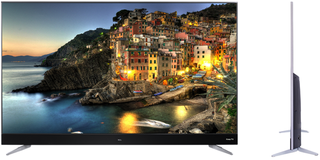
Sound
The reason you’d want to pick up a C-Series screen instead of the P-Series is two-fold. First, you’re in it for the sleeker design. The second reason, and the more pragmatic one, is for the enhanced audio. To that point, hidden underneath the mesh grille is a decently powerful set of speakers. (We’ll refer to it as a soundbar, although, technically speaking, we’re not sure it qualifies.)
With the soundbar in toe, the C-Series should theoretically offer a real advantage over other screens in TCL’s arsenal … it should, but in our opinion it doesn’t. Dialogue is still difficult to hear at times, even if the volume is around 50%. You’ll raise the volume in order to hear the dialogue, only to have a sudden burst of sound in the next scene.
Moreover, sound can come out a bit muddled if it’s not in the speaker’s tonal sweet spot - highs can become piercing and lower bass tones become distorted or less powerful than they could be with another set of speakers. The bass response doesn’t kick in until 80Hz or so, and that means much of those wall-shaking explosion effects come out to be nothing more than a dull roar.
That’s not to say the built-in option sounds bad - it doesn’t. It fulfills its role dutifully, if not perfectly. We just feel that a separate soundbar, generally speaking, might be a more cost-effective solution and would likely sound better in the vast majority of cases.
Sound TL;DR: The attached audio system on TCL’s C-Series wasn’t our favorite. It had some issues on the outer limits of the audio spectrum, reproducing dialogue and generally didn’t perform up to our expectations.
Final verdict
If all you’re looking for a low-cost, excellently designed and Dolby Vision-compatible 4K HDR TV, the C-Series encapsulates everything you’re looking for. It does all of the above without any issues, full stop. But, if you’re interested in better performance with HD/SDR content, audio and a direct-lit LED screen, well, you’ll have to look somewhere else.
All else equal, we’d recommend snatching the fantastic (and even cheaper) TCL P-Series P607. It’s only available in one size, 55-inches, but it offers a direct-lit screen with 4K HDR, Dolby Vision and Roku TV all for a little less than the 55C807 - just be sure to supply your own soundbar.
Nick Pino is Managing Editor, TV and AV for TechRadar's sister site, Tom's Guide. Previously, he was the Senior Editor of Home Entertainment at TechRadar, covering TVs, headphones, speakers, video games, VR and streaming devices. He's also written for GamesRadar+, Official Xbox Magazine, PC Gamer and other outlets over the last decade, and he has a degree in computer science he's not using if anyone wants it.
